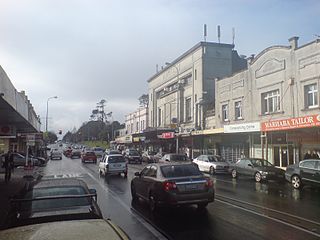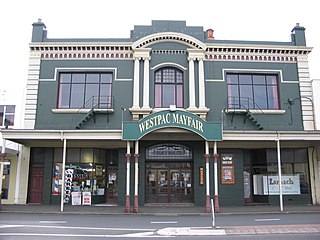
Cathedral Square, locally known simply as the Square, is the geographical centre and heart of Christchurch, New Zealand, where the city's Anglican cathedral, ChristChurch Cathedral is located. The square stands at the theoretical crossing of the city's two main orthogonal streets, Colombo Street and Worcester Street, though in practice both have been either blocked off or detoured around the square itself. The cathedral was badly damaged in the February 2011 Christchurch earthquake.

TheArts Centre Te Matatiki Toi Ora is a hub for arts, culture, education, creativity and entrepreneurship in Christchurch, New Zealand. It is located in the Gothic Revival former Canterbury College, Christchurch Boys' High School and Christchurch Girls' High School buildings, many of which were designed by Benjamin Mountfort. The centre is a national landmark and taonga as it is home to New Zealand's largest collection of category one heritage buildings with 21 of the 23 buildings covered by Heritage New Zealand listings.

George Street is the main street of Dunedin, the second largest city in the South Island of New Zealand. It runs for two and a half kilometres north-northeast from The Octagon in the city centre to the foot of Pine Hill. It is straight and undulates gently as it skirts the edge of the hills to its northwest. South of The Octagon, Princes Street continues the line of George Street south-southwest for two kilometres.

Balmoral is a suburb of Auckland, New Zealand that is bordered by Mount Eden, Epsom, Mount Roskill and Sandringham and is located approximately 5 km from the centre of Auckland. It was named around the turn of the 20th century and derives its name from Balmoral Castle, the Scottish country residence of the Royal family. Much of the housing in the area is from the 1920s and 1930s, often in the Californian Bungalow style. Balmoral was part of Mount Eden Borough Council which became a part of Auckland City in 1989. In November 2010, the area was included into the Albert-Eden-Roskill ward of the new Auckland Council.

The Octagon is the city centre of Dunedin, in the South Island of New Zealand. It is an eight-sided plaza with a circular one-way carriageway, bisected by the city's main street, and is also the central terminus of two other main thoroughfares. The Octagon is predominantly a pedestrian reserve, with grass and paved features, and is surmounted by a statue of the Scottish poet Robert Burns. Several of Dunedin's significant buildings and institutions adjoin the plaza, which is also a major hub for public transport in Dunedin, primarily taxi services.

Moray Place is an octagonal street which surrounds the city centre of Dunedin, Otago, New Zealand. The street is intersected by Stuart Street, Princes Street and George Street. Like many streets in Dunedin, it is named for a street in the Scottish capital Edinburgh.

The Regent Theatre is a theatre in Dunedin, New Zealand with a seating capacity of about 1,650. It is in The Octagon, the city's central plaza, directly opposite the Municipal Chambers and close to the Dunedin Public Art Gallery.

The D.I.C. was a New Zealand department store chain, founded in Dunedin by Bendix Hallenstein in 1884.

TheCivic Theatre is a large heritage combination performing-arts theatre, live-music venue, and cinema seating 2,378 people in Auckland, New Zealand. First opened on 20 December 1929, it underwent a major renovation and two-year conservation effort in the late 1990s, and was reopened on 20 December 1999. It is a famous example of the atmospheric theatre style wherein lighting and interior design create the illusion of an open sky complete with twinkling stars, giving the audience the impression of being seated in an outdoor auditorium at night. The Civic is managed by Auckland Live, a business unit of Auckland Unlimited.

Hanover Hall is a community arts centre and event venue in central in Dunedin, New Zealand, opened in 2018 as home to the Dunedin Symphony Orchestra. The building was built in 1912 as the Hanover Street Baptist Church, located in Hanover Street 1 kilometre (0.62 mi) northeast of the city centre, close to the Otago Medical School.

The Mayfair Theatre, Dunedin, New Zealand, was opened on 8 December 1914 as the "King Edward Picture Theatre". It is owned by the Mayfair Theatre Charitable Trust and serves as a 400-seat venue for live performances for a number of local community groups and as the Dunedin venue for some touring agencies.
Edward Sydney "Sidney" Luttrell and his brother Alfred Edward Luttrell (1865–1924) were partners of S. & A. Luttrell, a firm of architects and building contractors noted for its contributions to New Zealand architecture, both in terms of style and technology. The practice was established in Launceston, Tasmania in 1897 when Alfred who was operating his own architectural practice, went into partnership with his younger brother and former apprentice Sidney, under the original name A. & S. Luttrell. The brothers moved to Christchurch, New Zealand and by 1902 were submitting tender notices there. Sidney Luttrell was also noted for his keen interest in horse racing. He was a part-owner of Sasanoff, winner of the Melbourne Cup in 1916.

The Warehouse Precinct is an urban area of the New Zealand city of Dunedin. Sited on reclaimed land at the northernmost tip of the Southern Endowment, it lies between 1 and 2 kilometres south of The Octagon, the city's centre.

The Civic Theatre is a theatrical venue in the southern New Zealand city of Invercargill.

Henry Thomas Mandeno was a New Zealand modernist architect.

Shortland Street was the initial commercial street of Auckland and remains a key financial and legal centre for Auckland city. It runs east from Queen Street up to Princes Street, providing a connection from the business district to the Auckland High Court and University of Auckland.

The Oamaru Opera House and former Town Hall in Oamaru is a historic building and current performance venue on the east coast of the South Island of New Zealand. The building is classified as a "Category I" historic place by Heritage New Zealand Pouhere Taonga, previously known as the New Zealand Historic Places Trust.
Performing arts in New Zealand include amateur and professional presentations of theatre, circus, dance and music where it accompanies live performance. New Zealand has an active contemporary performing arts culture; many people participate in performing arts activities and most people live near an arts centre or theatre building.
Tracy Grant Lord is a leading New Zealand scenographer and costume designer of ballet, theatre and opera. She has worked with numerous Australasian performance companies including the Royal New Zealand Ballet, New Zealand Opera, Australian Ballet, Opera Australia, Queensland Ballet as well as the Auckland, Sydney, Melbourne and Queensland Theatre Companies.

























